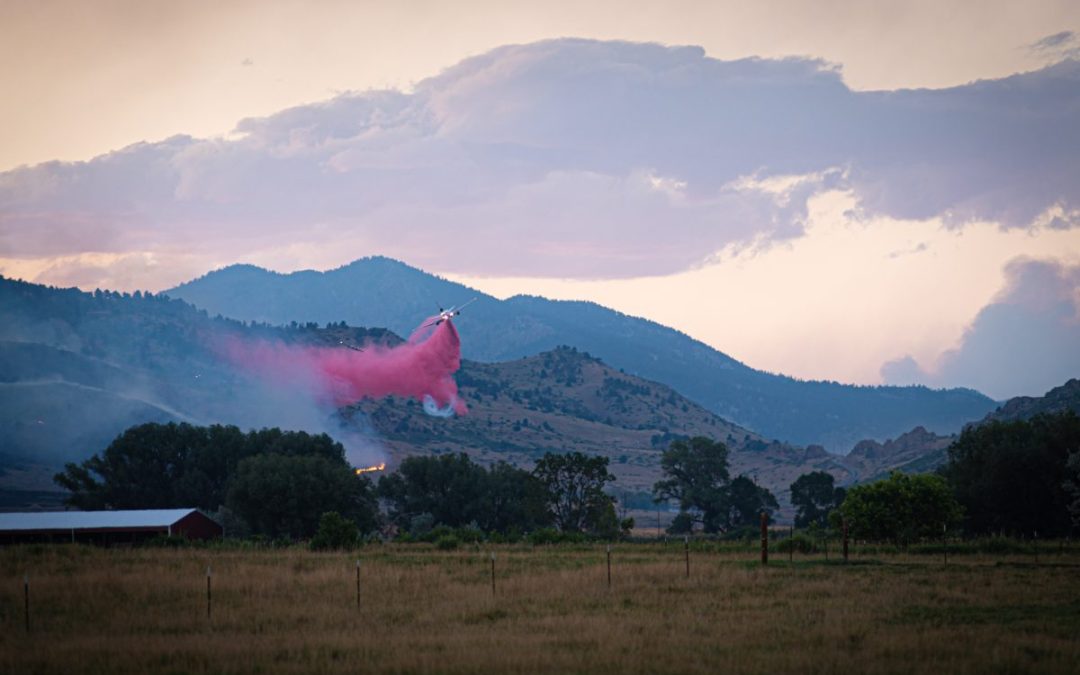As crews aggressively fight four Front Range wildfires, Colorado water officials say water delivery has not been interrupted even as they keep a close eye on nearby infrastructure that could be impacted.
The Alexander Mountain fire, the Stone Canyon fire, the Quarry fire and the Lake Shore fire led to one fatality, forced thousands of people from their homes, and burned structures as of Wednesday, even as dry and sweltering conditions are forecast to continue on the Front Range. Among the resources in the path of danger are reservoirs, power lines, treatment plants, and miles of canals and pipes that deliver water to cities, farms and ecosystems across the Front Range and eastern Colorado.
Between the Alexander Mountain and Stone Canyon fires, the construction site for a large infrastructure project, the Chimney Hollow Reservoir, was under mandatory evacuation Wednesday, said Jeff Stahla, spokesperson for Northern Water.
The future reservoir is part of the Colorado-Big Thompson Project, one of Colorado’s largest water delivery systems, which is managed by Northern Water and the U.S. Bureau of Reclamation.
Other parts of the Colorado-Big Thompson Project are also near the two fire areas. Carter Lake, east of the Alexander Mountain fire, is the main reservoir that stores and delivers water to the southeast for cities like Louisville, Superior, Broomfield, Fort Lupton and Fort Morgan.
“We’re still able to deliver water to the communities of the Front Range and to the water users,” Stahla said Wednesday afternoon.
The water in Horsetooth Reservoir and Carter Lake has been made available for aerial firefighting aircraft, Stahla said.
The Bureau of Reclamation has taken the Pole Hill hydropower plant near Carter Lake, another part of the Colorado-Big Thompson system, offline in response to the Alexander Mountain fire, according to spokesperson Anna Perea with Reclamation’s Eastern Colorado Area Office.
The move does not affect the amount of power available on the grid, although fire-affected areas may experience power outages. Flatiron hydropower plant, also near Carter Lake, remains online, she wrote in a prepared statement.
“We continue to deliver water to Carter Lake and Horsetooth reservoirs and have the ability to control water movement remotely, without putting staff at risk,” Perea said.
The 6,840-acre Alexander Mountain fire is also west of Loveland, where a city water treatment plant is in the evacuation zone. Staff were not evacuating the critical infrastructure as of Wednesday, said public information officer Tracey Hewson with Loveland Water and Power.
“We coordinated with Loveland Fire Authority, and we’re in close communications with them,” she said. “We would never put the lives of our staff in danger, so we’re monitoring the course of the fire very closely.”
The treatment plant was operating normally without any water quality issues as of Wednesday. Loveland Water and Power is doing water quality testing not only at the plant but at different points around town to make sure the water quality is excellent, Hewson said.
Farther south, fire-retardant slurry, which helps put out fires, was dropped into the St. Vrain Supply Canal Tuesday by tankers responding to the Stone Canyon fire near Lyons.
The canal flows into the Boulder Feeder Canal and then into Boulder Reservoir. As a result, the slurry has entered the reservoir, according to a news release Wednesday from the city of Boulder.
The slurry contains red dye, phosphorus and ammonia-based ingredients, which are not anticipated to harm human health, the city said. There is no risk to public health from the city’s drinking water.
At higher concentrations, the slurry may adversely affect aquatic life and wildlife. The city currently does not anticipate problems, but it advised residents against fishing and letting their dogs into the water on the reservoir’s north shore.
Also in Boulder County, a new fire ignited Wednesday afternoon near Gross Reservoir, which helps provide water to millions of people on the Front Range and is undergoing an expansion project. Residents living west and north of the reservoir were being told to evacuate and recreation at the reservoir was closed as of Wednesday afternoon.
Denver Water, which manages Gross Reservoir, is also closely monitoring the 200-acre Quarry fire north of Strontia Springs Reservoir for any potential impacts on operations. Past wildfires and rainfall contributed to a buildup of sediment in the reservoir that has reduced its water storage capacity and required costly repairs.
“Our primary focus is on the safety of our personnel and visitors to the area. Though Waterton Canyon is not currently in the evacuation zone, we ask that people avoid the area to give emergency crews space to respond,” wrote spokesperson Todd Hartman in a prepared statement Wednesday.
Looking ahead, water managers are keeping an eye out for rainstorms, which could help stall the wildfires — and can also carry sediment, sticks and other debris from burn areas into streams and can clog up water infrastructure, like treatment plants.
Although there is a chance for rain in the forecast for Friday, the National Weather Service does not expect to see significant rainfall this week.
Heading into next week, there are signs that the Front Range will cool slightly and could expect more significant rainfall toward the middle of the week, meteorologist David Barjenbruch said.
“At this point we’ve still got to get through quite a few days … of warm and relatively dry weather before we start to see an improvement,” he said.


 Print
Print